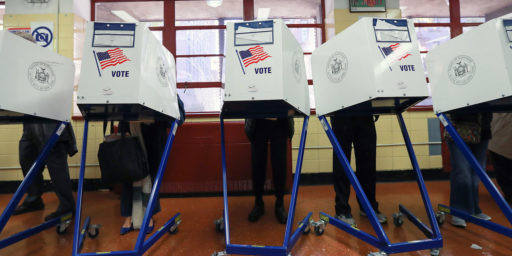Precinct Reporting Over
Starting Tuesday night, the results of statewide races will be reported by giving the percentage of "expected vote" rather than precinct-by-precinct.
Cook Political Report‘s Jennifer Duffy says that we’re in for a new way to present election numbers come Tuesday night:
For as long as anyone can remember, television networks and the Associated Press have reported votes on election night by saying, “With x percent of precincts reporting …” But, this method of reporting election results is about to go the way of the VCR.
Starting Tuesday night, the results of statewide races will be reported by giving the percentage of “expected vote.” The votes reported at the state level at any given time will be divided by the estimate of the total votes that will be cast in the state to come up with the percentage of expected votes.
“Percentage of precincts reporting” is no longer accurate because the increase in early and absentee voting can provide a skewed picture of how much of the vote has actually been counted. Some counties, for example, dump all their absentee votes and call it one precinct even though these votes may be half of the county’s total. Others report partial precinct results and keep adding to the total. And because absentee votes are often counted more slowly than votes cast on Election Day, the percentage of the vote reported even on Wednesday morning may be far short of 100 percent. In 2004, only 54 percent of the final vote in Washington State was counted by mid-day Wednesday.
The old way of reporting never made sense, given that precincts aren’t evenly weighted and we typically had no idea of knowing what the numbers really meant. Were these mostly “Republican” precincts or “Democratic” precincts? Then again, I’m not sure that the new method will fix the problem.
More interestingly, how does this new reporting method come about? Did the networks have some sort of conference and decide this? Or has there been some sort of national accord among election officials to start providing the data in a new way?
via the Mrs.







I must say, I like the idea. It’s at least worth a test-run. I think it will work best if the “total expected” is disclosed, so that projections can be modified if turnout proves to be higher (or lower) than expected.
But, at the very least, it’s worth a try. (And the % of precincts reporting value can always be given, or cross-referenced on SOS websites.)